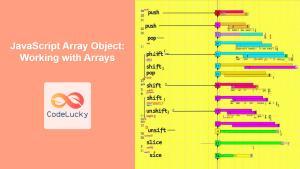JavaScript arrays are powerful data structures that allow us to store and manipulate collections of data. One of the most common operations performed on arrays is sorting. Whether you're organizing a list of names alphabetically, arranging numbers in ascending order, or sorting complex objects based on specific properties, JavaScript provides various methods to accomplish these tasks efficiently.
In this comprehensive guide, we'll explore the ins and outs of sorting arrays in JavaScript. We'll cover built-in methods, custom sorting functions, and advanced techniques to handle various sorting scenarios. By the end of this article, you'll have a solid understanding of how to sort arrays effectively in your JavaScript projects.
The Basic Array.sort() Method
At the heart of JavaScript array sorting is the Array.sort() method. This built-in function allows you to sort the elements of an array in place, meaning it modifies the original array.
Let's start with a simple example:
const fruits = ['banana', 'apple', 'orange', 'grape'];
fruits.sort();
console.log(fruits);
// Output: ['apple', 'banana', 'grape', 'orange']
In this case, the sort() method arranges the fruit names alphabetically. It's important to note that the default behavior of sort() is to convert elements to strings and compare their sequences of UTF-16 code units.
🔑 Key Point: The sort() method modifies the original array. If you need to preserve the original order, make a copy of the array before sorting.
However, this default behavior can lead to unexpected results when sorting numbers:
const numbers = [10, 2, 5, 1, 30];
numbers.sort();
console.log(numbers);
// Output: [1, 10, 2, 30, 5]
As you can see, the numbers are not sorted numerically but lexicographically as strings. To solve this, we need to use a compare function.
Using a Compare Function
The sort() method accepts an optional compare function as an argument. This function determines the order of the elements. It should return a negative value if the first argument is less than the second, zero if they're equal, and a positive value otherwise.
Here's how we can use a compare function to sort numbers correctly:
const numbers = [10, 2, 5, 1, 30];
numbers.sort((a, b) => a - b);
console.log(numbers);
// Output: [1, 2, 5, 10, 30]
In this example, (a, b) => a - b is our compare function. It subtracts b from a, which results in the correct numerical sorting.
🔍 Pro Tip: For descending order, simply reverse the comparison: (a, b) => b - a.
Sorting Objects
When working with arrays of objects, we often need to sort based on specific properties. Let's look at an example:
const people = [
{ name: 'Alice', age: 30 },
{ name: 'Bob', age: 25 },
{ name: 'Charlie', age: 35 },
{ name: 'David', age: 28 }
];
people.sort((a, b) => a.age - b.age);
console.log(people);
// Output:
// [
// { name: 'Bob', age: 25 },
// { name: 'David', age: 28 },
// { name: 'Alice', age: 30 },
// { name: 'Charlie', age: 35 }
// ]
Here, we're sorting the people array based on the age property. The compare function (a, b) => a.age - b.age compares the age values of two objects.
Case-Insensitive Sorting
When sorting strings, you might want to perform a case-insensitive sort. Here's how you can achieve this:
const names = ['Alice', 'bob', 'Charlie', 'david'];
names.sort((a, b) => a.toLowerCase().localeCompare(b.toLowerCase()));
console.log(names);
// Output: ['Alice', 'bob', 'Charlie', 'david']
In this example, we use the toLowerCase() method to convert both strings to lowercase before comparison. The localeCompare() method is used for string comparison, which is more robust than the simple < or > operators, especially for non-ASCII characters.
Sorting by Multiple Criteria
Sometimes, you need to sort an array based on multiple criteria. For instance, you might want to sort people by age, and then by name if the ages are equal. Here's how you can do that:
const people = [
{ name: 'Alice', age: 30 },
{ name: 'Bob', age: 25 },
{ name: 'Charlie', age: 30 },
{ name: 'David', age: 25 }
];
people.sort((a, b) => {
if (a.age !== b.age) {
return a.age - b.age;
}
return a.name.localeCompare(b.name);
});
console.log(people);
// Output:
// [
// { name: 'Bob', age: 25 },
// { name: 'David', age: 25 },
// { name: 'Alice', age: 30 },
// { name: 'Charlie', age: 30 }
// ]
In this example, we first compare ages. If they're not equal, we sort based on age. If they are equal, we then sort based on name.
Stable Sorting
As of ECMAScript 2019, the sort() method is guaranteed to be stable. This means that elements with equal sort keys will retain their relative order in the sorted array. This is particularly useful when sorting by multiple criteria or when maintaining the original order is important for equal elements.
Here's an example to illustrate stable sorting:
const items = [
{ id: 1, value: 'B' },
{ id: 2, value: 'A' },
{ id: 3, value: 'B' },
{ id: 4, value: 'A' }
];
items.sort((a, b) => a.value.localeCompare(b.value));
console.log(items);
// Output:
// [
// { id: 2, value: 'A' },
// { id: 4, value: 'A' },
// { id: 1, value: 'B' },
// { id: 3, value: 'B' }
// ]
Notice that the relative order of items with the same value is preserved.
Performance Considerations
While the sort() method is convenient and widely used, it's important to be aware of its performance characteristics, especially when dealing with large arrays.
🚀 Performance Tip: The time complexity of sort() can vary between browsers, but it's typically O(n log n) for large arrays. For very small arrays (usually less than 10 elements), some implementations may use insertion sort, which has O(n^2) complexity but performs well on small datasets.
If you're working with extremely large arrays and performance is critical, you might want to consider alternative sorting algorithms or libraries optimized for specific use cases.
Custom Sorting with Schwartzian Transform
For complex sorting scenarios, especially when the comparison operation is expensive, the Schwartzian Transform can be a useful technique. This method involves transforming the array, sorting it, and then transforming it back.
Here's an example where we want to sort an array of strings by their length, but the length calculation is assumed to be expensive:
const strings = ['apple', 'banana', 'cherry', 'date'];
const sorted = strings
.map(s => ({ original: s, length: s.length }))
.sort((a, b) => a.length - b.length)
.map(item => item.original);
console.log(sorted);
// Output: ['date', 'apple', 'banana', 'cherry']
In this example, we first map each string to an object containing the original string and its length. We then sort these objects based on the pre-computed length, and finally map back to the original strings.
Sorting with Internationalization
When dealing with strings that may contain non-ASCII characters or when you need to sort according to the rules of a specific locale, the Intl.Collator object comes in handy.
Here's an example of sorting strings with German umlauts:
const words = ['Äpfel', 'Zebra', 'äußerst', 'Autos'];
const collator = new Intl.Collator('de');
words.sort(collator.compare);
console.log(words);
// Output: ['Autos', 'äußerst', 'Äpfel', 'Zebra']
This sorting respects the German alphabet rules, where 'ä' is treated as a variant of 'a' and sorted accordingly.
Partial Sorting and Top-K Elements
Sometimes, you don't need to sort the entire array, but only want to find the top K elements. While you could sort the entire array and then slice it, there are more efficient approaches for large arrays.
Here's a simple implementation to find the top K elements:
function topK(arr, k) {
return arr
.slice()
.sort((a, b) => b - a)
.slice(0, k);
}
const numbers = [3, 1, 4, 1, 5, 9, 2, 6, 5, 3, 5];
console.log(topK(numbers, 3));
// Output: [9, 6, 5]
For very large arrays, more sophisticated algorithms like QuickSelect or heap-based methods would be more efficient.
Sorting in Reverse Order
To sort an array in reverse order, you have two options. You can either reverse the comparison in your sort function, or you can use the reverse() method after sorting:
const numbers = [3, 1, 4, 1, 5, 9, 2, 6, 5];
// Option 1: Reverse comparison
numbers.sort((a, b) => b - a);
console.log(numbers);
// Output: [9, 6, 5, 5, 4, 3, 2, 1, 1]
// Option 2: Sort and then reverse
numbers.sort((a, b) => a - b).reverse();
console.log(numbers);
// Output: [9, 6, 5, 5, 4, 3, 2, 1, 1]
Both methods will yield the same result, but the first option is generally more efficient as it avoids an extra pass through the array.
Handling Special Values
When sorting, it's important to consider how your comparison function handles special values like null, undefined, or NaN. These values can cause unexpected behavior if not handled properly.
Here's an example of how to handle null and undefined values when sorting:
const values = [3, 1, null, 4, undefined, 2, null, 5];
values.sort((a, b) => {
if (a === null || a === undefined) return 1;
if (b === null || b === undefined) return -1;
return a - b;
});
console.log(values);
// Output: [1, 2, 3, 4, 5, null, null, undefined]
In this example, we're pushing null and undefined values to the end of the array. You could also choose to put them at the beginning by reversing the comparison for these special values.
Sorting with a Custom Order
Sometimes you might need to sort elements based on a custom order that doesn't follow natural alphabetical or numerical order. You can achieve this by creating a mapping of elements to their desired order:
const fruits = ['banana', 'apple', 'cherry', 'date'];
const customOrder = ['cherry', 'banana', 'date', 'apple'];
const orderMap = new Map(customOrder.map((item, index) => [item, index]));
fruits.sort((a, b) => orderMap.get(a) - orderMap.get(b));
console.log(fruits);
// Output: ['cherry', 'banana', 'date', 'apple']
In this example, we create a Map that associates each fruit with its desired position. We then use this map in our comparison function to sort the fruits according to the custom order.
Conclusion
Sorting arrays is a fundamental operation in JavaScript programming, and mastering various sorting techniques can significantly enhance your ability to manipulate and organize data effectively. From basic sorting to handling complex objects, case-insensitive comparisons, and even custom ordering, JavaScript provides a flexible and powerful set of tools for array sorting.
Remember that while the built-in sort() method is suitable for most use cases, there may be situations where custom sorting algorithms or external libraries might be more appropriate, especially when dealing with very large datasets or when performance is critical.
By understanding these sorting techniques and considering factors like stability, performance, and special value handling, you'll be well-equipped to implement efficient and effective sorting in your JavaScript projects.
🎓 Learning Check: Try implementing a sorting function that can handle a mix of numbers and strings, sorting numbers numerically and strings alphabetically, with numbers always coming before strings. This exercise will help reinforce your understanding of custom sorting functions and type checking in JavaScript.
Happy coding, and may your arrays always be perfectly sorted! 🚀📊
- The Basic Array.sort() Method
- Using a Compare Function
- Sorting Objects
- Case-Insensitive Sorting
- Sorting by Multiple Criteria
- Stable Sorting
- Performance Considerations
- Custom Sorting with Schwartzian Transform
- Sorting with Internationalization
- Partial Sorting and Top-K Elements
- Sorting in Reverse Order
- Handling Special Values
- Sorting with a Custom Order
- Conclusion



















